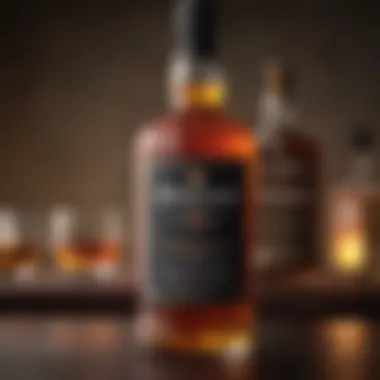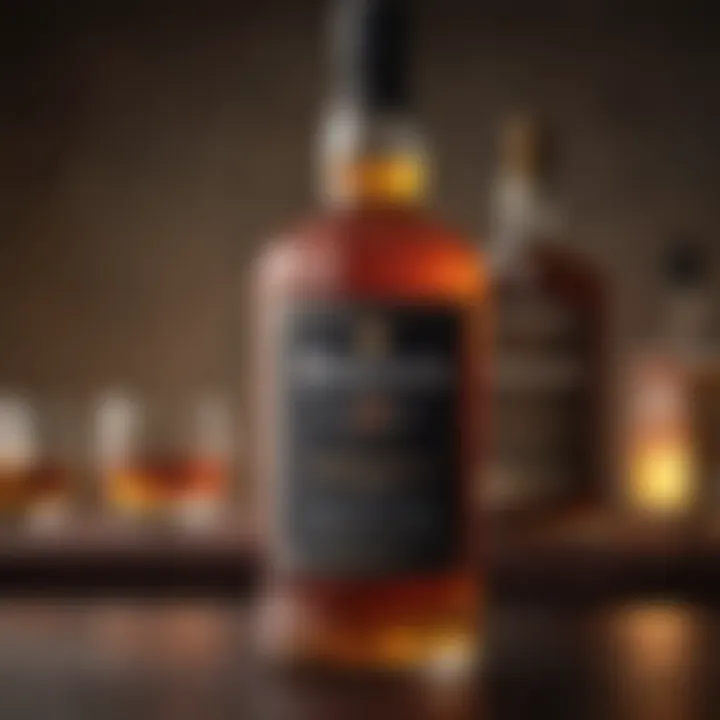The Ultimate Guide to Choosing the Best Whisky


Intro
Whisky stands as a storied spirit, revealing not only unique flavors, but also a rich cultural heritage. For centuries, people have embraced whisky, from its humble beginnings to becoming a symbol of refinement and craft. This exploration aims to present a comprehensive overview of the best whiskies available.
In this guide, we will dissect critical components that define whisky, including its production methods, historical significance, and tasting notes. We cater to both newcomers eager to learn and experts looking to refine their palate. The world of whisky is vast and inviting, making it essential to understand what influences taste, quality, and selection.
The discussion here encompasses the variety of brands and styles, focusing on the nuances that set each bottle apart. With that goal in mind, we will navigate through different categories and provide insightful recommendations. By the end of this guide, readers will possess the knowledge needed to appreciate whisky at a deeper level.
Prelims to Whisky
Whisky is more than just a drink; it is a complex tapestry of flavors, traditions, and cultures. Understanding whisky is essential for anyone looking to appreciate this spirit fully. This section delves into the definition, overview, and cultural significance of whisky, highlighting why it deserves thorough exploration. By gaining insight into these elements, readers can develop a deeper appreciation and make informed choices in their whisky journeys.
Definition and Overview
Whisky, often spelled as whiskey in Ireland and the United States, is a distilled alcoholic beverage made from fermented grain mash. Common grains used include barley, corn, rye, and wheat. Each type of whisky possesses unique characteristics influenced by its base ingredient, distillation method, and maturation process. Whisky is known for its diverse flavor profiles, ranging from sweet and fruity to smoky and earthy.
The classification of whisky can get quite intricate. Different regions produce distinct styles, and regulations vary by country. For example, Scotch whisky must be aged in oak barrels for a minimum of three years and must be produced in Scotland. Conversely, bourbon, primarily made from corn, is closely associated with American production. It is essential for enthusiasts to understand these definitions to appreciate the differences among various types.
Cultural Significance of Whisky
Whisky carries profound cultural significance across many societies. In Scotland, whisky is a source of national pride. Distilleries often incorporate local resources, creating a sense of identity and heritage. Festivals celebrate this drink, drawing tourists and locals alike to experience tastings and learn about history.
In Ireland, whiskey is not only celebrated but plays a role in traditional music and storytelling. Irish pubs are homes to convivial gatherings, where tales of the past intermingle with sips of pot still whiskey. Similarly, American bourbon has gained recognition as a cultural export, emblematic of Southern heritage and craftsmanship.
"Whisky is liquid sunshine." - George Bernard Shaw
This quote encapsulates the warmth and community that whisky fosters across various cultures. Understanding the cultural context of whisky enhances the drinking experience, connecting consumers to the stories behind each bottle. In essence, whisky is not merely a beverage to enjoy but a vessel carrying traditions and emotions from one generation to the next.
The History of Whisky
The history of whisky is a rich and intricate tapestry that captures the essence of distillation, tradition, and culture. Understanding its history is crucial not just for enthusiasts but also for anyone interested in the broader influences of whisky on societies. Each sip carries with it stories of innovation and mastery that span millennia. The development of whisky can be traced back to its origins, revealing how geography, climate, and human expertise shaped this beloved spirit.
Origin and Evolution
Whisky's origins can be traced back to the early medieval periods, with evidence suggesting that distillation began in ancient Mesopotamia. However, the beverage as we recognize it today likely started in Ireland and Scotland, around the 12th century. Early versions of whisky were often crude, utilized more for medicinal purposes than for enjoyment. The spirit was distilled from fermented grains, primarily barley. The word "whisky" is derived from the Gaelic term "uisge beatha," meaning "water of life."
The evolution of whisky continued through the following centuries. By the 15th century, records show that whisky was already being produced commercially, particularly in Ireland. There was a strategic diffusion of knowledge and techniques across borders, leading to different styles emerging in various regions, including the distinct identities of Scotch and Irish whiskey.
Key Historical Milestones
Several key milestones mark the development of whisky as we know it today.
- 1580: The first official license to distill whisky was issued in Scotland to the distillery at Glenlivet.
- 1823: The Excise Act led to a legal framework around whisky production in the UK, eliminating many illegal operations and fostering a more regulated market.
- 1860s: Advances in technology and the introduction of column stills revolutionized whisky production, allowing for better quality and higher yields.
- 20th Century: The global export of whisky began to flourish post-World War II, leading to international recognition and diverse consumer markets.
"Whisky is a blend of history, land, and human skill. Every bottle tells a unique story."
As the beverage transitioned from a localized product to a global phenomenon, cultural significance grew in tandem. Its storied past helps appreciate the craftsmanship that goes into each bottle, understanding the unique characteristics attributed to local traditions and ingredient sourcing. For the discerning palate, knowing the history enhances the experience of enjoying whisky, deepening the connection between the drinker and the spirit.
Whisky Production Methods


Understanding the methods of whisky production is vital for anyone looking to appreciate this storied spirit. The production process shapes the characteristics, flavors, and quality of the whisky. Each step in production plays a crucial role in determining the final product.
Ingredients: The Building Blocks
The primary ingredients used in whisky production are water, malted barley, grain, and yeast. Water must be pure, as it affects the taste significantly. Different regions use local sources, contributing to the unique flavors in their whiskies.
Malted barley is essential in many whiskies, particularly Scotch. It is soaked, germinated, and dried, which activates enzymes needed for fermentation. Other grains like corn and rye might be used, depending on the whisky type. Yeast transforms sugars into alcohol and carbon dioxide, impacting flavor development noticeably.
"The careful selection and quality of each ingredient influence the whisky’s identity.”
Distillation Processes
Distillation is a fundamental part of whisky making, typically involving two main approaches: pot still and column still distillation. Pot stills are often used in traditional distilleries for smaller batches, particularly in Scotch whisky. They allow for a richer, more complex flavor, capturing the essence of the raw ingredients.
Column stills, also known as continuous stills, provide higher efficiency and are common in the production of grains and bourbons. They facilitate large-scale production and result in a cleaner spirit. The distillation process helps refine the alcohol, concentrating flavors while removing unwanted elements.
Aging: Influencing Flavor and Aroma
Aging is where whisky develops its complexity. During this phase, whisky is stored in wooden casks, typically made of oak. The wood not only supports a variety of chemical interactions but also imparts distinct flavors. An important factor is the duration of aging; longer aging can enhance richness but also risks over-extraction of wood tannins, leading to bitterness.
The cask's previous use affects the whisky too. A barrel that once held sherry, for example, can impart dried fruit notes, while bourbon barrels contribute vanilla and caramel traits. Environmental conditions like temperature and humidity also play a significant role, influencing how whisky interacts with the wood.
Factors to Consider When Choosing Whisky
Choosing whisky is not always straightforward. There are many elements that impact the selection process. By understanding these factors, one can make more informed choices. The importance of these factors cannot be overstated, especially considering the wide variety of whiskies available on the market today.
Types of Whisky: An Overview
Whisky comes in various forms, each with its own characteristics and flavor profile. Understanding these types helps consumers appreciate the diversity in whisky production.
Scotch
Scotch whisky, typically produced in Scotland, is known for its distinct peaty flavor. Its key characteristic is the use of malted barley. Scotch must be aged in oak barrels for a minimum of three years, which adds complexity. This ageing process is beneficial as it allows flavors to mature and develop. However, the variability in taste can be a disadvantage, as not every Scotch may appeal to all palates.
Irish Whiskey
Irish whiskey is often triple distilled, making it smoother than many other types. Its key feature is the use of unmalted barley, which results in a light, approachable flavor. This smoothness makes Irish whiskey a popular choice for beginners. Yet, its lighter profile may not satisfy those seeking a bolder drinking experience.
Bourbon
Bourbon must be produced in the United States and contains at least 51% corn. This unique requirement results in a sweeter taste, often with notes of vanilla and caramel. The popularity of bourbon continues to grow, especially for those who enjoy cocktails. However, bourbon's sweetness can be somewhat one-dimensional compared to other whisky varieties.
Rye
Rye whisky has a spicy kick, primarily because it is made from at least 51% rye grain. This feature distinguishes it from bourbon and makes it a favorite among those who enjoy a bold flavor. Rye whisky is beneficial for individuals looking for something unique and complex. The downside might be that its spiciness can be overwhelming for some.
Alcohol Content and Proof
Alcohol content is a crucial consideration. It typically ranges from 40% to 50% ABV (Alcohol by Volume) for most whiskies. Higher alcohol content often means more intense flavors. Understanding proof can help in determining how the whisky might be consumed, whether neat, on the rocks, or in cocktails. Always consider your preference and tolerance when selecting.
Packaging and Presentation


The packaging of whisky can significantly affect perception. Bottles come in various designs that often reflect the brand's identity. Moreover, some whiskies are presented in decorative boxes, which enhance their appeal as gifts. However, it is crucial to not rely solely on packaging; substance and flavor must match the presentation.
In the end, choosing whisky is a nuanced endeavor. By considering types, alcohol content, and packaging, consumers can navigate the market more effectively. Each element plays a role in the overall experience and appreciation of whisky.
Tasting Notes and Flavor Profiles
Tasting notes and flavor profiles are crucial when it comes to appreciating whisky. These aspects provide insight into the characteristics of different whiskies. Understanding these elements helps consumers make informed selections based on personal preferences. Additionally, recognizing tasting notes can enhance a whisky drinking experience by allowing consumers to identify flavors and aromas that appeal to them. Each whisky tells its own story through its unique combination of tasting notes, making this section essential for all whisky enthusiasts.
Describing Aroma and Taste
The aroma and taste of whisky are key components that define its identity. Aroma usually sets the stage before tasting even begins. It prepares the palate for what is to come. Aroma can hint at sweetness, spice, fruitiness, or smokiness. On the other hand, taste unveils the complexities of flavors that develop on the palate. A good whisky should offer a harmonious blend of these elements. A well-rounded whisky will have pleasant aromas and a balanced taste profile.
Common Flavor Notes
In whisky tasting, several common flavor notes stand out. Each category highlights different characteristics that appeal to different drinkers.
Fruity
Fruity notes often contribute a sweetness to whisky. They can include flavors like apple, pear, or citrus. These notes are a beneficial choice as they tend to be approachable for new whisky drinkers. The key characteristic of fruity notes is their ability to add a refreshing quality. A unique feature of fruity flavors is their role in balancing out stronger elements, like alcohol. However, some connoisseurs may find fruity profiles less complex than others.
Spicy
Spicy notes are significant in many whiskies, especially in bourbons and ryes. Cinnamon, clove, and black pepper are common descriptors. The key characteristic of spicy notes is their ability to add warmth and depth to the whisky. Spicy profiles can be beneficial for those who enjoy a more robust flavor. A unique feature of spicy flavors is their ability to linger on the palate. However, if overly pronounced, they may overshadow subtler flavors.
Woody
Woody notes are often associated with whisky aged in barrels. This aspect contributes depth and richness. Common woody flavors range from oak to cedar. These notes enhance the overall taste experience and offer complexity. The key characteristic of woody flavors is their ability to provide a foundation upon which other flavors can develop. However, if too strong, woody notes can dominate, leading to an imbalanced profile.
Peaty
Peaty notes are primarily found in Scotch whiskies, especially those from Islay. They are often described as earthy or smoky. The key characteristic of peaty flavors is their distinctive intensity, which can be divisive. For some, these notes make a whisky memorable. However, for others, a strong peat flavor can be overwhelming. The unique feature of peat is its ability to create a sense of place, connecting the drinker to the region where the whisky is produced.
"The journey of whisky appreciation starts with understanding its tasting notes and flavor profiles, inviting the drinker to explore a world of unique experiences."
In summary, tasting notes provide valuable insight into a whisky's composition. Fruity, spicy, woody, and peaty notes each offer distinct qualities and contribute to the full range of whisky experiences. Understanding these elements allows drinkers to tailor their selections to match their preferences.
Recommended Whiskies on the Market
Selecting the best whisky can be an overwhelming task, considering the vast variety available today. This section highlights a curated list of recommended whiskies. Each whiskey brings a unique character, reflecting not only its ingredients but also its origin and production methods. Exploring these options enhances appreciation and allows individuals to make informed choices according to their personal preferences. Understanding these selections is essential for both seasoned enthusiasts and those new to whisky.
Top Scotch Whiskies
Scotch whisky represents a classic tradition in whisky production, famously known for its rich flavors and distinct regional characteristics. The following selections are esteemed examples within the category of Scotch whisky:
- Lagavulin 16 Year Old: Known for its smoky, peaty aroma, Lagavulin offers robust flavors with a hint of sweetness.
- Glenfiddich 12 Year Old: This whisky is floral and fruity, making it quite approachable for those new to Scotch.
- Macallan Sherry Oak 12 Year Old: Macallan is celebrated for its premium quality, with rich notes of dried fruits and spices derived from sherry cask aging.
Each of these Scotch whiskies demonstrates the versatility and depth of flavor that can be found within this category.
Best Irish Whiskeys
Irish whiskey has gained recognition for its smoothness and complexity. Here are some suggestions:


- Redbreast 12 Year Old: This single pot still whiskey brings full-bodied flavors with a mellow finish.
- Jameson: A widely known brand, Jameson offers a blend of pot still and grain whiskey, resulting in a light and uplifting experience.
- Teeling Small Batch: Teeling stands out with its unique cask finish, imparting richer flavors than some traditional Irish whiskeys.
These options showcase the nuances in Irish whiskey, making them worthy candidates in any collection.
Notable Bourbons
Bourbon is an American whisky distinguished by its significant corn content and sweet flavor profile. Here are some must-try bourbons:
- Buffalo Trace: Offering a balance of sweet and spicy notes, this bourbon is versatile and widely respected.
- Woodford Reserve: Known for its smooth texture, it has a complex flavor profile with hints of oak and caramel.
- Wild Turkey 101: A higher proof bourbon, this option retains robust flavors, perfect for cocktails or sipping neat.
Bourbon lovers will appreciate the diverse selections available today, each with its unique twist.
Exceptional Rye Whiskies
Rye whisky is distinguished by its spicy flavor profile and is gaining traction among whisky enthusiasts. Notable selections include:
- Mark VII Rye: A rich and complex rye, offering spiciness paired with fruity undertones.
- Bulleit Rye: Has a high rye content, leading to a bold flavor that is a favorite in cocktails.
- Sazerac Rye: Known for its smooth drinkability, Sazerac provides a well-balanced experience with hints of vanilla and spiciness.
These exceptional rye whiskies illustrate the growing popularity of this category and provide delightful tasting experiences.
Exploring Whisky Culture
The realm of whisky extends beyond mere consumption; it encompasses a rich tapestry of culture that varies across different regions and communities. This section examines how culture shapes the whisky experience, providing insights into the social and historical context surrounding this spirit. Understanding whisky culture deepens appreciation and informs choices, making it an essential topic for enthusiasts and newcomers alike.
Whisky in Different Cultures
Whisky holds a valued position in societies where it is produced. Each culture infuses its unique identity into the creation and enjoyment of whisky. In Scotland, for instance, whisky is not just a drink but a symbol of national pride, recognized globally as Scotch. The production methods, regulations, and heritage maintain its national significance.
Similarly, in Ireland, whiskey (spelled with an "e") is closely tied to the community and local traditions. Distilleries often have historical stories that reflect their roots in Irish history, emphasizing the role of family and locality in production. Each country has specific types and styles which reveal unique flavors, traditions, and consumption practices.
- Scotch: Typically distilled twice and known for its smoky peaty flavors, Scotch varies in style from the Highlands to the Lowlands.
- Irish Whiskey: Smooth and triple-distilled, it often displays a lighter taste that appeals to a broader audience.
- American Bourbon: This spirit reflects American ingenuity. Its sweet and caramel notes differentiate it from its peers.
Festivals and Events Celebrating Whisky
Events celebrating whisky offer remarkable opportunities for enthusiasts to immerse themselves in this culture. Festivals often include tastings, masterclasses, and meet-and-greets with distillers. Such gatherings foster a sense of community and shared passion, bringing together people who appreciate whisky as more than just a beverage.
Notable festivals include:
- The Islay Whisky Festival: A celebration of the island’s distilleries, renowned for its peaty whiskies.
- Whisky Live: Held in various global cities, featuring tastings from diverse whisky producers.
- The Feis Ile: A vibrant festival on Islay, blending whisky tasting with music and local festivities.
"Whisky is a spirit that connects people, transcending borders and cultural boundaries."
These events not only introduce participants to new brands and flavors, they also provide education about different whisky styles and production methods. Understanding whisky culture enhances the experience, cultivating a deeper respect for this age-old craft.
The End
In this article, we thoroughly explored the rich and diverse world of whisky. From its historical roots to its modern-day production techniques, each aspect plays a crucial role in shaping our understanding and appreciation of this complex spirit. The discussion highlighted how cultural significance intertwines with whisky enjoyment, offering insights into how whisky influences social interactions and personal moments.
Final Thoughts on Whisky Appreciation
Appreciating whisky extends beyond taste alone. It involves understanding the craftsmanship behind every bottle. Each region, whether it is Scotland, Ireland, America, or Canada, contributes distinct characteristics to their whiskies. This offers a tapestry of flavors waiting to be explored. Whisky tastings serve as opportunities to familiarize oneself with these nuances. Additionally, engaging with knowledgeable communities can deepen your appreciation. As you savor different expressions, consider the stories behind them. The journey of discovery makes whisky appreciation a rewarding endeavor.
Encouragement to Explore Diverse Options
Diversity is one of whisky's most appealing aspects. Whether you prefer smooth bourbons or peaty scotches, there is something to satisfy every palate. Do not hesitate to step outside your comfort zone. Try whiskies from various regions, or explore limited editions and craft distilleries. Understanding the characteristics of different types, such as Scotch, Irish whiskey, bourbon, and rye, can help you identify what you enjoy the most. Embrace the concept of experimenting with food pairings as well. Whisky can enhance meals, enriching flavors in a unique way. So, throughout your journey, keep an open mind and savor the many experiences whisky has to offer.
"Whisky is liquid sunshine." - George Bernard Shaw







